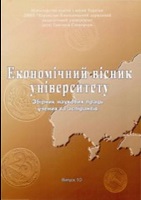КОНЦЕПТУАЛЬНІ ЗАСАДИ АВТОМАТИЗАЦІЇ ОБЛІКУ ПРАЦІ ТА ЗАРПЛАТИ ПРАЦІВНИКІВ АГРАРНИХ ПІДПРИЄМСТВ
CONCEPTUAL PRINCIPLES OF AUTOMATION OF ACCOUNTING FOR WORK AND SALARIES OF EMPLOYEES OF AGRICULTURAL ENTERPRISES
Author(s): Svitlana Koval, Svitlana Skrypnyk, Inesa ShepelSubject(s): Business Economy / Management, Agriculture, Labor relations, Fiscal Politics / Budgeting, Accounting - Business Administration
Published by: Університет Григорія Сковороди в Переяславі
Keywords: accounting; analytical; synthetic; work; salary; employees; agricultural enterprises; programs; savings; social payments; taxes; reports; management;
Summary/Abstract: The subject of the study is the theoretical and practical aspects of automating labor and salary accounting in agricultural enterprises. The purpose of the article is to substantiate the conceptual foundations of automating the accounting of labor and wages of employees of agricultural enterprises, to identify differences in its directions and to evaluate competitive advantages and results for the needs and improvement of management. The methodological basis of the article was dialectical, historical, monographic, system-structural analysis and synthesis; economic comparisons; special methods of accounting. Results of the article. It was determined that the automation of accounting for labor and wages of employees of agricultural enterprises provides them with significant competitive advantages of development and management efficiency due to simplification, acceleration, objectivity and high quality of accounting; significant cost savings for its implementation; availability for management and owners. At the same time, three conceptual approaches to automation with corresponding software products, spheres and tools of their influence, and expected results are substantiated. This is the automation of the accounting of typical calculations and payments with integration into the general information system of the enterprise; automation of the accountant's workplace; combined with a combination of the first two. Their comparison is made and advantages and disadvantages, perspectives of use are shown. Field of application of results. The obtained results can be used in the work of accounting offices of enterprises, in the scientific and educational process of agrarian universities. Conclusions. In order to increase the efficiency of managing the development of agricultural enterprises on the basis of the automation of labor accounting and employee salaries, it is important to implement the latest software products for its support. In particular, we may be talking about a more improved version of the program «1C: Salary and Personnel Management 8.3». This version is very productive for both accounting specialists and PH-management of enterprises, because it provides: definition, assessment, diagnosis, forecasting and planning of personnel needs; management of attestation, training and financial motivation of employees; effective planning of employment of employees from an overview on the seasonality of agricultural work; personnel record keeping and personnel analysis; maintaining staffing in agricultural enterprises. Another large set of advantages concerns the automation of calculations provided by the named advanced version of the program. We are talking about the automation of employee salary calculations; taxes regulated by legislation, withholdings from wages and accruals to the wage fund; accruals and deductions according to any algorithms; display of accrued wages and taxes as part of enterprise expenses. It is also management of cash settlements with employees, including depositing; formation of settlement sheets of any kind; formation of payment information with the arrangement of information according to various criteria by dividing it by categories of employees, types of work, divisions and other features; calculation of sick leaves, vacations, premiums, bonuses and incentives.
Journal: Економічний вісник університету
- Issue Year: 2022
- Issue No: 55
- Page Range: 47-53
- Page Count: 7
- Language: Ukrainian

